-
How Lightfoot and housing activists reached an uneasy détente in the battle for Woodlawn’s future
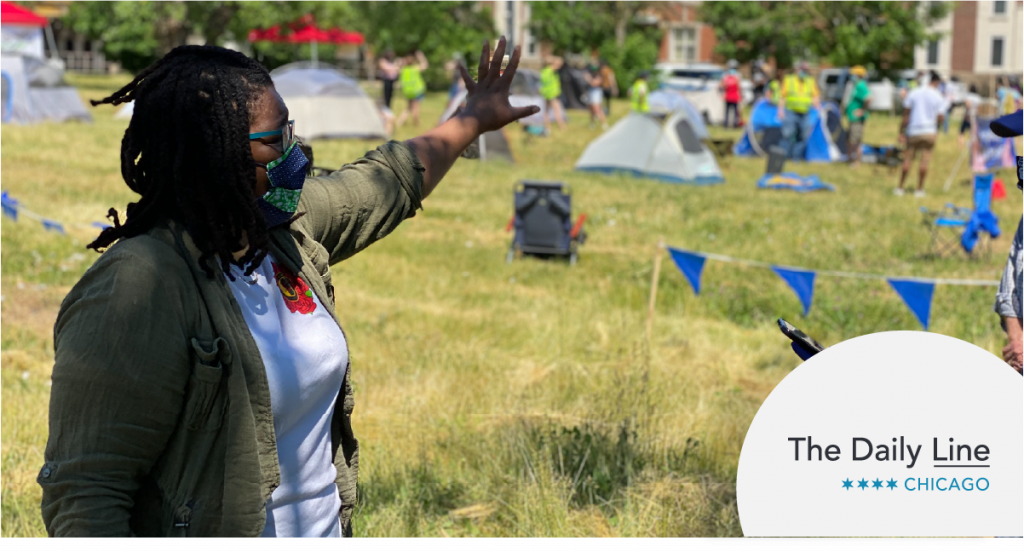
After dozens of tense community meetings, months of shut-it-down protests and nearly a year of City Council politicking, city officials and Woodlawn residents have struck a deal to secure the future of their neighborhood.
“It looks like we might have an ordinance that I might co-sponsor,” Ald. Jeanette Taylor (20) told The Daily Line last week.Those were the magic words Mayor Lori Lightfoot and her sprawling administration of housing and planning officials had been waiting for all year as they’ve tried to get Taylor on board with their proposal designed to protect and expand affordable housing in Woodlawn. Such an agreement will allow Lightfoot to say she fulfilled campaign promise to back a Community Benefits Agreement (CBA) in Woodlawn — although activists have pushed for a much more expansive suite of protections for vulnerable tenants and homeowners.
On Sunday, Lightfoot’s administration secured a commitment from the coalition and other Woodlawn stakeholders to back a compromise ordinance, housing officials said. Taylor confirmed Monday that she would cosponsor the measure, which is set to be formally introduced to the City Council on Wednesday.
While the ordinance is far less sweeping than a competing measure Taylor and her allies backed last year, housing activists scored fresh concessions from city officials on provisions targeting low-income renters. The latest draft also includes extra measures aiming to help low- and middle-income earners buy homes in the neighborhood, where home prices have more than tripled in the past five years.
Taylor, whose activist credentials include taking part in a 2015 hunger strike to protest the planned closure of Dyett High School, is still getting used to the art of compromise, she said.
“When you come from community organizing, it’s all or nothing,” Taylor said. “This doesn’t do enough, but it would be irresponsible to walk away with nothing for the community.”
The freshman alderman emphasized that she was taking her cues from constituents — particularly the Coalition for a CBA, a legion of five neighborhood groups demanding concrete defenses against gentrification expected to emanate from the $500 million Obama Presidential Center in Jackson Park. The coalition has been pushing Lightfoot to crank up housing protections in the ordinance, organizing a blockade of her fifth-floor office in February and more recently erecting a “tent city” in Woodlawn to drive their message last month.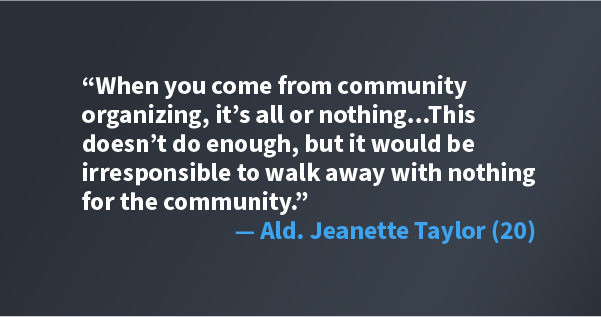
The détente represents a major victory for Lightfoot and Novara, who have withstood withering criticism from Taylor and coalition members this year over their approach to housing policy
Novara and her staff kept negotiations running despite deep distrust between Lightfoot and members of the CBA Coalition, many of whom opposed Lightfoot’s candidacy. Officials also tried to balance the coalition’s demands against other groups of Woodlawn residents — particularly homeowners and business owners — who fought to widen the spigot of outside investment, with fewer restrictions.
In the beginning, ‘tense’ negotiations
Calls for a Community Benefits Agreement date back to 2016, when the Obama Foundation announced Jackson Park as the site of Obama’s presidential library. The foundation — and the 44th president himself — repeatedly swatted away those pleas, promising that the center would “not displace residents” and arguing that it was unreasonable to find any single organization that spoke for the entire area. Former Mayor Rahm Emanuel, Obama’s former White House chief of staff, backed him up.
But organizers refused to let up, and when the question was posed to candidates during the 2019 election for mayor, Lightfoot said a firm agreement would be needed to prevent displacement and make sure residents see the “benefits of this enormous investment,” the Tribune reported at the time.
Novara and her team in the housing department set out to hammer out an agreement in fall 2019 with a “working group” of several dozen city officials, Obama Foundation staffers and members of Woodlawn community groups, including the CBA Coalition.
“The first meeting was very tense,” recalled Duwain Bailey, a director with the non-profit Network of Woodlawn, a community development group.
“Everybody was dug into their positions, and there was a lot of distrust on all sides,” Bailey said. “Personally, I didn’t think it was going to go anywhere.”
Leaders of the coalition said they were frustrated the city had not taken up an ordinance (O2019-5589) Taylor introduced in July 2019 that set binding measures meant to protect Woodlawn neighbors from displacement. The ordinance included a mandate that any new development within two miles of the Obama project is to have 30 percent of its units affordable, and it forced the creation of a city-backed “trust fund” to support the construction of new affordable units across the area.
Twenty-eight of Taylor's colleagues backed the ordinance, including Ald. Leslie Hairston (5), whose ward includes the Obama Center site and a small slice of Woodlawn. But Ald. Harry Osterman (48), Lightfoot’s hand-picked chair of the City Council Committee on Housing and Real Estate, never brought the proposal up for a vote.
Osterman declined to comment for this article.
Instead, the housing department in February of this year unveiled a scaled-back suite of protections that would give tenants right of first refusal for apartment building sales and require certain levels of affordable development on city-owned land, among other measures.
“For far too long, your voices have been ignored,” Lightfoot wrote in an open letter to Woodlawn neighbors accompanying the release of the draft. Her priority, she said, was “to listen.”
Taylor and her allies in the coalition hit back at the mayor, saying her proposal came up short.
Jawanza Malone, executive director of the Kenwood-Oakland Community Organization and a lead organizer with the CBA Coalition, said negotiations had already led to “a ton of tension” that “boiled over” when the new ordinance came out. It left organizers feeling that their voices had been ignored, he said.
“What’s the point of us being here if you’re still going to do what you were going to do anyway?’” Malone said he remembered thinking. “That’s the way Rahm operated. That’s the way former Mayor Richard M. Daley operated. This mayor said she was going to be different.”
Taylor was also unsatisfied. She said Novara and her policy team “took bits and pieces that they liked, and they took out what really helps us hold folks accountable.”
City: Taylor not only voice in room
Novara countered that she and her staff had “sat down with Alderwoman Taylor and walked her through every concern we had with the CBA ordinance” alongside city attorneys, specifying “what we felt we could do instead, and why, on multiple occasions.”
She also added that Taylor and her allies in the coalition do not speak for all the residents of Woodlawn — some of whom, like Bailey and the Network, opposed the CBA ordinance.
“The voices of the folks involved in the CBA Coalition are incredibly important and powerful, as are the voices of many others we have heard from in this process,” Novara said. “The role that I'm in is to make the space to hear multiple points of view...and to try to reconcile those points of view with a path forward that is feasible.”
Hairston, who co-sponsored Taylor’s original ordinance, also disputed the idea that Taylor’s proposal had been swept aside. She described the housing department's draft proposal as a natural result of a long legislative process, saying the CBA proposal “had some very good parts that were put into the [Lightfoot administration’s] housing ordinance.”
'Those people won’t be protected’
Instead of setting guard rails on development that would apply to the whole neighborhood, the city’s February proposal set a narrower target. Its affordability requirements only applied to new construction that would sprout from the 208 residential vacant lots owned by the city.
Specifically, the ordinance required that at least 20 percent of units in any apartment building of 15 units or more be held to rents affordable to tenants who make up to 80 percent of the area median income — nearly $73,000 for a family of four. Five percent of units would have to be held for tenants earning up to 50 percent of median income, and another 5 percent would be for renters earning up to 30 percent.
Malone said that would likely only protect a few dozen renter households in the area.
“That was completely unconscionable, given that there are 9,900 households at risk of displacement” in Woodlawn, Malone said.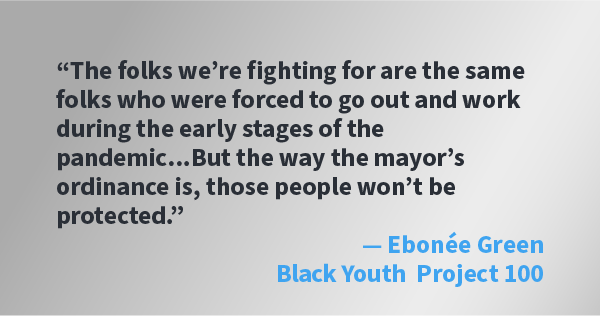
The draft ordinance from the mayor’s office lacked other key components from Taylor’s proposal. It would only apply to Woodlawn, instead of drawing a two-mile radius around the Obama Center as the original proposal called for, leaving out big swaths of Washington Park and South Shore. And the city’s draft lacked any mention of a city-backed trust to perpetually fund affordable housing, an idea put forward by the coalition.
Ebonée Green, an organizer with Black Youth Project 100, another member group of the Coalition for a CBA, said she was “galled” by the “amazing sleight of hand” deployed by city housing officials who sought to shrink the ordinance’s footprint and cut the trust proposal. But organizers have agreed to cut those if they can squeeze stronger renter protections out of the ordinance.
A two-bedroom apartment held affordable to renters making 80 percent of Area Median Income could still cost around $1,600 per month — too high to protect the most vulnerable residents, Green said.
“The folks we’re fighting for are the same folks who were forced to go out and work during the early stages of the pandemic — the [nursing assistants], the grocery store workers,” Green said. “But the way the mayor’s ordinance is, those people won’t be protected.”
The latest version of the ordinance, which is backed by the coalition, cranks up requirements by mandating that 30 percent of new units on 25 percent of city-owned vacant land — equaling about 52 lots — be held affordable to tenants making less than 50 percent of median income.
Hairston: ‘We are talked out’
The rift between Taylor and the Lightfoot administration persisted through May, when the alderman urged the Chicago Plan Commission not to approve the Woodlawn Plan Consolidation Report, a document drafted by city planners that aimed to synthesize more than a dozen community plans developed in Woodlawn during the past 20 years.
Taylor made her support for the report conditional on passage of a housing ordinance, but the commission approved adopting the document anyway. It was a rare break from the unwritten rules of aldermanic privilege, under which planning decisions usually hinge on sign-off from the local alderman.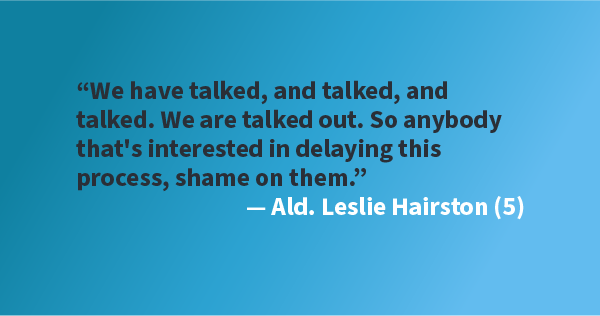
Hairston supported adoption of the report, saying the time for community input had passed.
“You've got people saying, ‘this is an emergency, it has to be done now, and that was a year ago,” Hairston told The Daily Line. “And now they're saying ‘oh, it's going too fast.’ I think that's a stall tactic.”
“We have talked, and talked, and talked,” Hairston added. “We are talked out. So anybody that's interested in delaying this process, shame on them.”
In the end, a meeting in the middle
In the debate around how deep affordability protections should go, a central sticking point has hardened around a question organizers and city officials answer differently: are renters already being pushed out of Woodlawn?
In an interview with The Daily Line in February, Novara said her staff shaped the ordinance on the principle that everyone who lives in Woodlawn now should be able to stay there — but that so far, data shows the most dramatic price changes have hit single-family homes on the east side of Woodlawn, rather than indicating a widespread purge of renters.
Data from the real estate brokerage Redfin shows that the median home sale price in Woodlawn was $200,000 in May, nearly quadrupled from $59,000 in May 2015. While organizers have said apartment rents are moving in the same direction, Novara said the city has not seen enough data to be certain.
Novara has also pointed toward a formidable contingent of Woodlawn residents who have been lobbying the city to pave the way for a bigger contingent of middle-class residents.
Bailey of the Woodlawn Network pointed to growing the neighborhood’s population — and particularly its crop of homeowners — as one of his group’s highest priorities.
“By increasing homeownership, you’re increasing the number of people who have a stake in the community and are participating to make sure that the community can be all that it can be,” Bailey said.
To that end, the department’s draft ordinance includes a $500,000 infusion into the Renew Woodlawn, a grant program aimed at incentivizing middle-income investors to buy and rehab neighborhood homes. It sets aside another $1 million for the Woodlawn Long-term Homeowner Home Improvement Grant Program, which helps longtime homeowners pay for renovations.
The compromise ordinance also added a commitment from the housing department to apply for another $675,000 in federal grant funds for Renew Woodlawn, and it loosened eligibility rules for the Home Improvement Grant Program.
It includes other renter-focused provisions, like a $1.5 million public financing pool for apartment owners who agree to keep their units affordable, and a mandate that tenants get “right of first refusal” to buy an apartment building before their landlord sells it to someone else.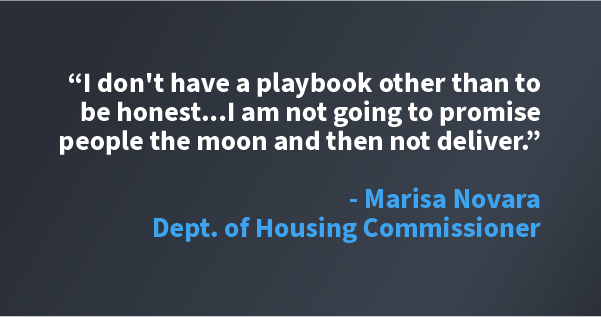
Novara has defended the balance her department struck in setting affordability mandates, saying heavier requirements would likely make construction too expensive for private developers to shoulder without government subsidies that stretch the city’s public financing tools.
Activists say they’re skeptical of Novara’s claim. But the commissioner said her years of experience managing affordable housing development for the Lawndale Christian Development Corporation left her with a deep understanding of builders’ limits.
“I know what it means to grapple with how to get a project financed, to have to make tough decisions about how low you can set the rents,” Novara said. “I don't have a playbook other than to be honest about those realities. I am not going to promise people the moon and then not deliver.”
For Taylor, the end product of months of negotiations is far from what she wanted, she told The Daily Line. But the freshman alderman also said that the existence of an ordinance in the first place is a clear sign that “organizing works.”
Taylor said that she has “respect” for Novara, even though the doesn’t “agree with her policies” and wishes the housing department had done more to run community meetings “from the ground up.”
Taylor also gave a nod to Lightfoot — particularly her intergovernmental affairs staffers, who she said, “were at the table early on” and worked hard to forge an agreement.
“I still don’t feel like the mayor understood where I was coming from,” Taylor said. “But I respect her saying from the beginning that this needed to be taken care of, and her willingness to do something.”
“So this is probably the first time, and probably the last, that me and her are going to agree on something,” Taylor added with a laugh.
This project is a collaboration of seven Chicago newsrooms examining Mayor Lori Lightfoot's administration. Partners are the BGA, Block Club Chicago, Chalkbeat Chicago, The Chicago Reporter, The Daily Line, La Raza and The TRiiBE.
Do you like this page?













